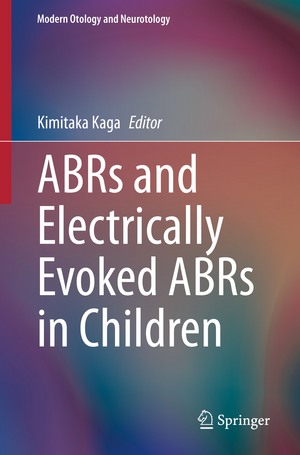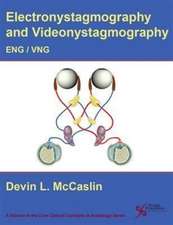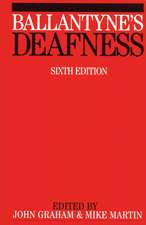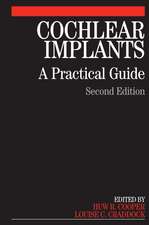ABRs and Electrically Evoked ABRs in Children: Modern Otology and Neurotology
Editat de Kimitaka Kagaen Limba Engleză Hardback – 30 oct 2022
The book will also cover auditory neuropathy, its numerous and new sub-classifications. Readers will be thoroughly briefed on all the new perspectives in interpreting data. Researchers and clinicians will find the text to be a valuable tool in the correct diagnosis of hearing problems and neurological diseases among babies and infants.
Preț: 785.77 lei
Preț vechi: 827.13 lei
-5% Nou
Puncte Express: 1179
Preț estimativ în valută:
150.36€ • 157.38$ • 125.14£
150.36€ • 157.38$ • 125.14£
Carte disponibilă
Livrare economică 10-24 martie
Preluare comenzi: 021 569.72.76
Specificații
ISBN-13: 9784431541882
ISBN-10: 4431541888
Pagini: 150
Ilustrații: XI, 266 p. 219 illus., 33 illus. in color.
Dimensiuni: 155 x 235 mm
Greutate: 0.59 kg
Ediția:1st ed. 2022
Editura: Springer
Colecția Springer
Seria Modern Otology and Neurotology
Locul publicării:Tokyo, Japan
ISBN-10: 4431541888
Pagini: 150
Ilustrații: XI, 266 p. 219 illus., 33 illus. in color.
Dimensiuni: 155 x 235 mm
Greutate: 0.59 kg
Ediția:1st ed. 2022
Editura: Springer
Colecția Springer
Seria Modern Otology and Neurotology
Locul publicării:Tokyo, Japan
Public țintă
Professional/practitionerCuprins
Part 1 Introduction.- 1 History of ABR and EABR.- Part 2 ABRs.- 2 Origins of ABR.- 3 Gestational development of the human auditory system including the cochlea and the central auditory pathways.- 4 ABR recording technique and the evaluation of peripheral hearing loss.- 5 Auditory neuropathy spectrum disorders.- 6 Normalization and deterioration of ABR configuration in child neurology.- 7 Hypoxic and Anoxic Brain Damage.- 8 Only wave I, II of the ABR with residual hearing acuity.- 9 Auditory agnosia and later cortical deafness in a child over 29 years follow-up.- Part 3 Electrically Evoked ABRs (EABRs).- 10 Electrically evoked Auditory Brainstem Responses (EABRs), Recording Techniques, Normal (Control) and Abnormal Waveforms of the EABR.- 11 Inner ear malformation and cochlear nerve deficiency.- 12 Auditory neuropathy.- Part 4 Particular Topics.- 13 Common Cavity Deformity.- 14 Galvanic VEMP.
Notă biografică
Kimitaka Kaga, MD, PhD. is the emeritus professor of University of Tokyo and the emeritus director of National Institute of Sensory Organs in National Hospital Organization Tokyo Medical Center. He graduated from the School of Medicine in the University of Tokyo. His academic specialty is otology, neurotology and audiology. His surgical specialty is otological surgery including cochlear implant, cosmetic and functional reconstruction for microtia and atresia, and tympanoplasty. His academic concern is central auditory processing, auditory plasticity and vestibular failure and compensation in children. He is the president of Tokyo Branch of the ORL Society of Japan Inc., and the former president of Otological Society of Japan. Now he works in two institutes of The National Institute of Sensory Organs and Kamio Memorial Hospital, Audiology Clinic in Tokyo.
Textul de pe ultima copertă
For more than 40 years, Auditory Brainstem Responses (ABRs) have been used as a diagnostic tool for hearing disorders and brainstem disorders in the pediatric audiology and neurotology and child neurology. While there are many publications in this field, this new volume will review hearing problems and neurological disorders in babies, infants and children, and discuss important new advances such as ABR figure and threshold changes with infant development.
The book will also cover auditory neuropathy, its numerous and new sub-classifications. Readers will be thoroughly briefed on all the new perspectives in interpreting data. Researchers and clinicians will find the text to be a valuable tool in the correct diagnosis of hearing problems and neurological diseases among babies and infants.
Caracteristici
Provides a comprehensive review of the basic science of development of the auditory system Discusses in detail such developmental changes as threshold changes in auditory brainstem responses Of special interest to researchers and clinicians working in audiology and neurotology and in pediatric neurology













